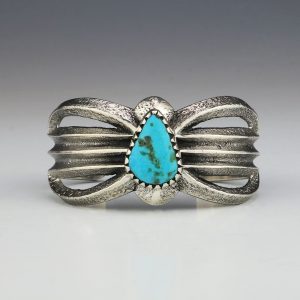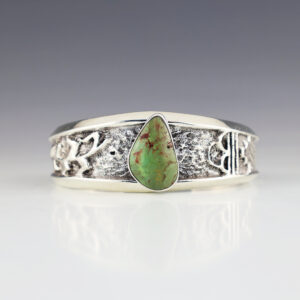KINGMAN TURQUOISE BRACELET BY GARY CUSTER NAVAJO
In the mid 1800s, Navajo silversmiths started to use sand casting as one of their silversmithing techniques. Today, silversmiths still use this technique by carving a design in tufa stone (a porous limestone) and then placing another stone against it. The two pieces are fastened together and molten silver is...
NATIVE AMERICAN NAVAJO SPINY OYSTER BRACELET BY GARY CUSTER
In the mid 1800s, Navajo silversmiths started to use sand casting as one of their silversmithing techniques. Today, silversmiths still use this technique by carving a design in tufa stone (a porous limestone) and then placing another stone against it. The two pieces are fastened together and molten silver is...
NATIVE AMERICAN NAVAJO SPINY OYSTER ZIA BRACELET BY GARY CUSTER
In the mid 1800s, Navajo silversmiths started to use sand casting as one of their silversmithing techniques. Today, silversmiths still use this technique by carving a design in tufa stone (a porous limestone) and then placing another stone against it. The two pieces are fastened together and molten silver is...
NATIVE AMERICAN NAVAJO STERLING SILVER & LAPIS BRACELET BY KELSEY JIMMIE
In the mid 1800s, Navajo silversmiths started to use sand casting as one of their silversmithing techniques. Today, silversmiths still use this technique by carving a design in tufa stone (a porous limestone) and then placing another stone against it. The two pieces are fastened together and molten silver is...
NATIVE AMERICAN NAVAJO STERLING SILVER & TURQUOISE BRACELET BY GARY CUSTER
In the mid 1800s, Navajo silversmiths started to use sand casting as one of their silversmithing techniques. Today, silversmiths still use this technique by carving a design in tufa stone (a porous limestone) and then placing another stone against it. The two pieces are fastened together and molten silver is...
NATIVE AMERICAN NAVAJO STERLING SILVER & TURQUOISE BRACELET BY GARY CUSTER
In the mid 1800s, Navajo silversmiths started to use sand casting as one of their silversmithing techniques. Today, silversmiths still use this technique by carving a design in tufa stone (a porous limestone) and then placing another stone against it. The two pieces are fastened together and molten silver is...
NATIVE AMERICAN NAVAJO STERLING SILVER & TURQUOISE BRACELET BY MILDRED PARKHURST
In the mid 1800s, Navajo silversmiths started to use sand casting as one of their silversmithing techniques. Today, silversmiths still use this technique by carving a design in tufa stone (a porous limestone) and then placing another stone against it. The two pieces are fastened together and molten silver is...
NATIVE AMERICAN NAVAJO TURQUOISE BRACELET BY GARY CUSTER
In the mid 1800s, Navajo silversmiths started to use sand casting as one of their silversmithing techniques. Today, silversmiths still use this technique by carving a design in tufa stone (a porous limestone) and then placing another stone against it. The two pieces are fastened together and molten silver is...
NATIVE AMERICAN ZUNI INLAY BRACELET BY PHIL WEAHKEE
This eye-catching bracelet showcases the remarkable skill of Zuni artist Phil Weahkee. Turquoise, Coral, and Jet stones inlaid into a sterling silver setting. This beautiful bracelet will be a great addition to your Native American jewelry collection Weighs 10 grams. The entire inner circumference is about 6 1/4”, including 1 ...
NATIVE AMERICAN ZUNI STERLING SILVER & TURQUOISE BRACELET
This extraordinary bracelet showcases great channel inlay work. Sterling silver with vivid blue turquoise inlay. This stunnning braclet will compliment any outfit. Weighs 20 grams. Signed. The entire inner circumference is about 6 1/4”, including 1 1/16” opening. (this bracelet cannot be bent to fit your wrist) 3/8” wide Zuni...
NATIVE AMERICAN ZUNI TURQUOISE BRACELET BY MIRENDA PEYNETSA
This eye-catching bracelet showcases the remarkable skill of Zuni jeweler Mirenda Peynetsa. Vivid blue turquoise stones inlaid into a sterling silver setting. This beautiful bracelet will be a great addition to your Native American jewelry collection Weighs 8 grams. The entire inner circumference is about 6 1/2”, including 1 1/4”...
NATIVE AMERICAN ZUNI TURQUOISE NEEDLEPOINT BRACELET BY EDMUND COOEYATE
This bracelet will be a delight to wear, as well as a good representation of the fine craftsmanship of Edmund Cooeyate. Edmund is known for his fine needlpeoint work. This gorgeous bracelet is made out of sterling silver and Turquoise. Weighs 14 grams. Signed. The entire inner circumference is about...
NAVAJO KINGMAN TURQUOISE BRACELET BY GARY CUSTER
In the mid 1800s, Navajo silversmiths started to use sand casting as one of their silversmithing techniques. Today, silversmiths still use this technique by carving a design in tufa stone (a porous limestone) and then placing another stone against it. The two pieces are fastened together and molten silver is...
NAVAJO SPINY OYSTER BRACELET BY GARY CUSTER
In the mid 1800s, Navajo silversmiths started to use sand casting as one of their silversmithing techniques. Today, silversmiths still use this technique by carving a design in tufa stone (a porous limestone) and then placing another stone against it. The two pieces are fastened together and molten silver is...
NAVAJO STERLING SILVER & TURQUOISE BRACELET BY GARY CUSTER
In the mid 1800s, Navajo silversmiths started to use sand casting as one of their silversmithing techniques. Today, silversmiths still use this technique by carving a design in tufa stone (a porous limestone) and then placing another stone against it. The two pieces are fastened together and molten silver is...
NAVAJO STERLING SILVER & TURQUOISE BRACELET BY GARY CUSTER
In the mid 1800s, Navajo silversmiths started to use sand casting as one of their silversmithing techniques. Today, silversmiths still use this technique by carving a design in tufa stone (a porous limestone) and then placing another stone against it. The two pieces are fastened together and molten silver is...
NAVAJO STERLING SILVER & TURQUOISE BRACELET BY GARY CUSTER
In the mid 1800s, Navajo silversmiths started to use sand casting as one of their silversmithing techniques. Today, silversmiths still use this technique by carving a design in tufa stone (a porous limestone) and then placing another stone against it. The two pieces are fastened together and molten silver is...
NAVAJO STERLING SILVER & TURQUOISE BRACELET BY KEVIN BILLAH
Navajo silversmith Kevin Billah made this outstanding bracelet out of sterling silver and Turquoise. The entire inner circumference is about 6 1/2”, including 1 1/8” opening. (Fits a 6 1/2″ wrist) Weighs 42 grams. Signed. 1 7/16″ wide Artist card included The Navajos began working with silver in the...
NAVAJO STERLING SILVER & TURQUOISE DRAGONFLY BRACELET BY KELSEY JIMMIE
In the mid 1800s, Navajo silversmiths started to use sand casting as one of their silversmithing techniques. Today, silversmiths still use this technique by carving a design in tufa stone (a porous limestone) and then placing another stone against it. The two pieces are fastened together and molten silver is...
NAVAJO TURQUOISE ZIA BRACELET BY GARY CUSTER
In the mid 1800s, Navajo silversmiths started to use sand casting as one of their silversmithing techniques. Today, silversmiths still use this technique by carving a design in tufa stone (a porous limestone) and then placing another stone against it. The two pieces are fastened together and molten silver is...
ROYSTON TURQUOISE BRACELET BY GARY CUSTER NAVAJO
In the mid 1800s, Navajo silversmiths started to use sand casting as one of their silversmithing techniques. Today, silversmiths still use this technique by carving a design in tufa stone (a porous limestone) and then placing another stone against it. The two pieces are fastened together and molten silver is...
SPINY OYSTER SAND CAST BRACELET BY GARY CUSTER NATIVE AMERICAN
In the mid 1800s, Navajo silversmiths started to use sand casting as one of their silversmithing techniques. Today, silversmiths still use this technique by carving a design in tufa stone (a porous limestone) and then placing another stone against it. The two pieces are fastened together and molten silver is...
STERLING SILVER & TURQUOISE BRACELET BY GARY CUSTER NAVAJO
In the mid 1800s, Navajo silversmiths started to use sand casting as one of their silversmithing techniques. Today, silversmiths still use this technique by carving a design in tufa stone (a porous limestone) and then placing another stone against it. The two pieces are fastened together and molten silver is...























